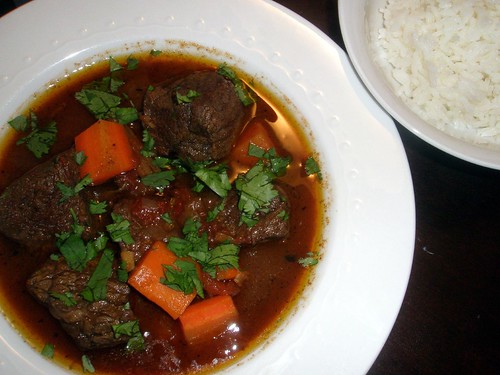Every Sunday, I try to find time to cook a large meal with enough leftovers so that I get to skip out on cooking dinner at least a few nights during the week. During the cooler months, my go to Sunday night meals tend to be braises. In the warmer months, I go for roast meats, and my absolute favorite roast meat is char siu, a Vietnamese dish consisting of strips of pork shoulder strips that are marinated in a sweet soy sauce mixture, then roasted at very high heat so that the pork on a beautiful reddish brown color. Crispy on the outside, with a healthy dose of juicy pork fat interspersed throughout the meat, absolutely no other roast meat beats char siu. Best of all, unlike the usual monotony that comes with leftovers, leftover char siu lends itself to a wide variety of uses; I have tried it by itself, mixed in with fried rice, and over a bed of noodles. Each preparation reminded me why I love the dish so much.
Char Siu
Adapted from Into the Vietnamese Kitchen
Ingredients:
- 2 lb. boneless pork shoulder, well trimmed
- 2 cloves garlic
- 2 tbsp sugar
- 1/2 tsp Chinese five-spice powder
- 3 tbsp Hoisin
- 2 tbsp honey
- 1 1/2 tbsp Shaoxing rice wine
- 2 tbsp soy sauce
- 1 tbsp double black (thick) soy sauce
- 2 tsp sesame oil
- Quarter the pork lengthwise into 1 1/2 inch thick strips.
- Combine all of the remaining ingredients in a large bowl. Add the pork to the marinade and cover. Refrigerate overnight, turning the pork a few times as it marinates to ensure that all sides are well-covered in marinade.
- Preheat the oven to 475F.
- Place a flat roasting rack on a baking tray lined with foil. Place the pork on the roasting rack and place it in the oven.
- As the pork roasts, baste it with the marinade every ten minutes and turn the pork. Roast until the pork begins to char on the outside and is cooked through, about 35 minutes.
- Remove the pork from the oven and let it rest for 10 minutes. Using a sharp knife, slice the pork strips into very thin slices. Serve the pork as desired.









